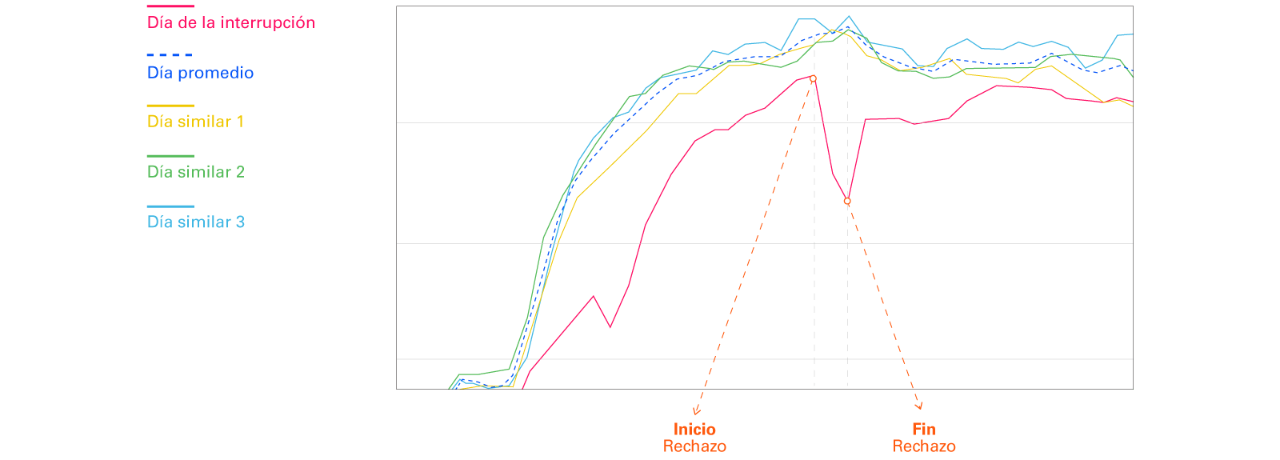According to the Peruvian standards, compensations due to electric power interruptions are defined in the Electric Concession Act (Decree-Law No. 25844) and its Regulations (Supreme Decree No. 009-93-EM) and the Technical Regulation for the Quality of Electrical Services (NTCSE, after its name in Spanish) (Supreme Decree No. 020-97-EM-) and amendments, from which some general extracts we present as follows:
Article 86 of the Electric Concession Act establishes that “if the power supply suffers total or partial interruption for a period of more than four (04) consecutive hours, the concessionaire will compensate the users for the cost of the power and energy not supplied, in accordance with the conditions established by law, except in the cases in which they were due to a cause attributable to the affected user.”
Paragraph a) of Article 168 of the Regulations of the Electric Concession Act lays down that “all interruption periods surpassing four (04) consecutive hours should be registered by the concessionaire. The user can communicate the event to the concessionaire to obtain compensation”. Additionally, this article specifies that “planned cut-offs informed to the users 48 hours in advance shall not be considered for this purpose.”
According to the provisions of the NTCSE, the quality of the electrical services is based on the continuance of the power supply and, in order to evaluate quality, some indicators that measure the number of power supply interruptions, their duration and the energy not supplied during the interruptions are considered. The interruption control period is six (06) calendar months.
In number 6.1.2 of the NTCSE, an interruption means the lack of power supply at a delivery point. Interruptions can occur due to many reasons, including the removal of equipment from the power supply facilities or other facilities that supply power to them, which is produced because of maintenance, switching, extensions, etc., or randomly due to failures and faults, which includes those that have been timely planned. In this Regulation, a total power supply interruptions of less than three (03) minutes or interruptions related to force majeure events duly proven and classified by the Authority are not considered.
Likewise, the NTCSE specifies that the suppliers must compensate their customers for power supply whose quality of service has not met the tolerance levels established according to their voltage:
Number of interruptions by customer (N’)
Customers in very high and high voltage 02 interruptions / semester
Customers in medium voltage 04 interruptions / semester
Customers in low voltage 06 interruptions / semester
Total weighted duration of interruptions by customers (D’)
Customers in very high and high voltage 04 hours / semester
Customers in medium voltage 07 hours / semester
Customers in low voltage 10 hours / semester
According to the statements above, the compensation pursuant to the Electric Concession Act (Decree-Law No. 25844) and the Technical Regulation for the Quality of Electrical Services shall apply accordingly, taking into account the tolerance levels established in those standards.
Due to the nature of the power supply business, our service is exposed to interruptions at power generation, transmission or distribution, and if they have an unforeseen cause, it is advisable for customers to have a contingency and protection system in place that minimizes the impact that those interruptions may have on their electrical equipment and critical activities.
The Technical Regulation for the Quality of Electrical Services (NTCSE, after its name in Spanish) is approved by means of Supreme Decree No. 020-97-EM dated 9 October, 1997. The objective of this standard is to set the minimum quality levels for the electrical services and the obligations of the power supply companies and customers that operate under the umbrella of the Electric Concession Act (Decree-Law No. 25844).
The application of this standard is mandatory for power supply services related to power generation, transmission and distribution subject to price regulations and applicable to electricity supply subject to the free price system, in all matters that the parties have not agreed or have agreed otherwise.
It is applied in the following aspects:
Product Quality
This is the evaluation of deviations in voltage tolerances at the delivery points.
The indicator of voltage quality is carried out monthly (Control Periods), whereas the minimum measurement period is 7 calendar days in a row (Measurement Period).
The indicator to evaluate the output voltage in a measurement period (k) of fifteen (15) minutes is the difference (ΔVK) between the instantaneous root mean square values (RMS) measured at the delivery point (VK) and the nominal voltage value (VN) at the same point.

If the voltage is outside the established tolerance range for a period longer by 5% of the measurement period, then the power quality is poor.

Compensation is calculated for the measurement period based on the power supplied in poor quality conditions during such period, using the following formula:

Where:
P: measurement period
a: unit compensation (0.05 US$/kwh)
Ap: factor of proportionality that is defined in the indicator Vk(%), measured in the “p” period.
Ep: power in kwh supplied during the “p” measurement period.

Once the poor quality is detected, we send the report to COES, register data and request them to determine who is responsible for the poor quality.
Within 15 calendar days after receiving the request and based on the corresponding assessment, COES informs OSINERGMIN and the companies involved, in a well-documented and founded manner, who is responsible for the poor quality.
This information shall be used for the corresponding compensation.
Quality of Power Supply
This is based on the continuance of electrical services for the customers, i.e. it is related to service interruptions. The interruption control period is 6 calendar months.
In order to evaluate the quality of power supply, indicators that measure the number of power supply interruptions, their duration and the energy not supplied are considered.
Interruption means all lack of power supply at a delivery point due to different reasons (disconnection, maintenance, faults, etc.). In this Regulation, power supply interruptions that last less than three (03) minutes or interruptions related to force majeure events duly classified by the Authority are not considered.
In this Regulation, interruptions are classified as follows:
Interruption at the Delivery Point: Interruptions where the busbar is put out of service (Voltage=0 and t>3 minutes) due to disconnections because of maintenance, faults or switching.
Interruption due to Load Rejection: Interruptions due to the opening of feeder’s switches (t>3 minutes) because of the following reasons:
- Automatic load rejection for protection actions of Minimum Frequency and/or Minimum Voltage.
- Manual load rejection by decision of the Coordinator of the Real-Time Operation of the System (COES).
The quality of electricity supply is evaluated considering the 2 following indicators that are calculated for control periods of six months:
| Indicator | Tolerance | |
| High voltage |
Medium voltage |
|
| N : total number of interruptions (interruptions/six-month period) |
2 | 4 |
| D : Weighted total duration (*) of interruptions (hours / six-month period) |
4 | 7 |
Compensation is estimated for six-month periods based on the Energy not Supplied Theoretically (ENS), the number of interruptions by customer per six-month period (N) and the Total Cumulative Duration of Interruptions (D):
Compensation due to interruptions (PE) = e * E * ENS
Where:
e: Unit compensation = 0.05 US$/kwh
E: Factor that considers the magnitude of indicators of electricity supply quality and tolerance levels.
ENS: Energy not Supplied Theoretically to a determined Customer.

Where:
N, D are quality indicators
N', D' are tolerance indicators
Compensation is calculated per feeder every six months based on the Energy not Supplied Theoretically (ENSf) and a factor of proportionality that depends on the number of interruptions (NRCF) and the Total Duration in hours (DRCF):
Compensation due to interruptions (RC) = e * Ef * ENSf
Where:
e: Unit compensation = 0.05 US$/kwh
Ef: Factor that considers the number of interruptions and their duration.
ENSf: Energy not Supplied Theoretically to a line or feeder during a six-month period.

The Energy not supplied theoretically per line or feeder during a six-month period is as follows:


Where:
ENSf,k: Energy not Supplied Theoretically to a determined line or feeder for the individual duration (dk) of each interruption expressed in kW.h.
pk: Power supplied by the line or feeder in the moment the interruption occurred.
dk: Individual duration of the power supply interruption.
“k”: It represents each interruption.
“i”: It represents each line or feeder.
ENSTf,k: This is the Total Amount of Energy not Supplied Theoretically due to Load Rejection evaluated at the energy supply point as the comparison between the load profile for the day the interruption occurred due to load rejection and the load profile of the corresponding normal day.

